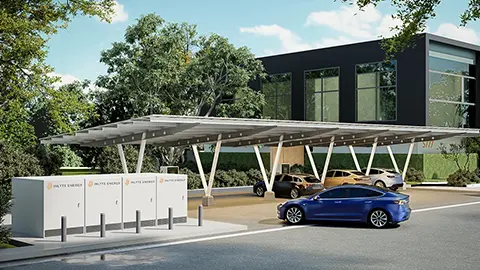The Transformation of Auto Retail
The last decade has seen more transformation in the technology driving our automobiles than the previous century. The shift towards electrification, partially driven by customer demand, partly driven by legislation and incentives designed to reduce greenhouse gas emissions, has resulted in an incredible number of new-tech cars entering the market. Initially, these came in the form of simple hybrid vehicles that use both a gasoline engine and an electric motor for better fuel economy. More recently, they have been supplanted by more sophisticated plug-in hybrids and all-electric vehicles.
As the share of electrified vehicles continues to grow, how will that affect the car dealership business? On the one hand, electric vehicles should require a lot less maintenance than the internal combustion vehicles we’re used to driving; on the other hand, their technology, and the nuances around charging, require more work on the sales floor for a customer to have a positive experience.

Auto Retail Expert, Chris Cooley, Continues to Promote EVs
Chris Cooley thinks about these questions a lot. In his role as Director of Marketing Strategy at Lithia & Driveway, the second-largest publicly-traded dealer group in the U.S., he’s not only responsible for promoting the electric vehicles sold across the group’s 260-plus store network; he also needs to think about processes in the sales and service departments required to deliver an exceptional experience. As an EV convert himself, Cooley has first-hand experience buying and servicing two electric cars, knowledge he’s put to good use as Lithia & Driveway proactively embraces green driving.

Sales Volume and Familiarity
More than just sales or service procedures, he thinks that green vehicles represent a culture shift within the dealership. “Right now, we know that electric vehicles represent relatively low volumes in the context of what we sell every year, and sometimes that means that at the dealer level, hybrid and electric vehicles get neglected,” Cooley says. “For brands that are new to electric, and at smaller stores, you’re looking at two or three vehicles a month, and at that volume, it’s hard to build a trained sales staff that can really talk about the product with confidence to customers. And if the sales team isn’t confident in a product, they’ll divert customers to something they are confident in.”
Some brands are better than others. Cooley notes that, “Toyota launched the Prius more than 20 years ago, so as a brand, it probably has the highest mix of electrified cars; they’ve done a good job with training, and Toyota stores are familiar with the product, so new electric products are easier to introduce.”
Compared to a gasoline-powered vehicle, determining exactly how much a plug-in hybrid or electric vehicle is going to actually cost can be a challenge, too. The traditional OEM sales incentives can, depending on location, be enhanced by federal, state, and local credits designed to encourage the purchase of green cars, which can alter the price by thousands of dollars.

The Right EV at the Right Price
“Getting accurate pricing is actually complicated for a customer and for salespeople,” says Cooley. “There’s this perception out there that an electric car is more expensive than a regular gas car, but with all of the incentives available, it can be on par or even less. Tools like GreenCars’ EV incentive tool can help with this, but we also need to do a better job of training our salespeople so that we can help customers make the right decision for them.”
At least in the initial stages of the transition to electric, Cooley found that “customers often came into dealerships with more information than the staff; there was a real gap in terms of our sales teams’ knowledge of what they were selling.”
Salespeople also now have to sell much more than the car and associated finance and protection products – there’s the whole topic of home charging, which is key to an EV customer having a great experience. Cooley’s first electric vehicle was a Fiat 500e, which he followed up with a BMW i3; neither sales experience adequately considered the topic of home charging.
“The Fiat was a city car with a relatively short range of about a hundred miles, so it had a small battery, and I could charge it overnight using a conventional 120-volt plug. Then I moved to the i3, which had a much bigger battery, which needed a lot longer to charge. Had I known that I should have upgraded to a level two (220 volt) charger, I would have had a much better experience. Being able to explain home charging to customers and providing resources for the stores and customers to help facilitate home charging: will be important in the future, as this is still one area of confusion.”

Getting Hooked on Electric Vehicles
Even with the post-purchase hiccups, Cooley considers himself an EV advocate, something he feels more dealership staff will become as they experience electric driving. “I really got hooked on the Fiat, and let a friend of mine that’s a veterinarian try it out,” he says. “This guy was your stereotypical, outdoorsy pickup truck kind of guy, but after driving my Fiat, he bought a Chevy Bolt, and has embraced it one hundred percent. He loves the convenience, is tracking his savings on a cost-per-mile basis using an app, and even got his business partner into an EV. They’ve had a couple of hiccups with range being less in the winter, but quickly figured it out after making some adjustments to the way they drive.”
Of course, selling cars is just one part of the dealership business; parts and service often represents half a dealership’s income, and EVs have the potential to be much more disruptive in the workshop. “I read the owner’s manual pretty thoroughly when I got the Fiat. The most eye-opening component was that the first scheduled maintenance, other than tires, was at 100,000 miles… to have the roof rails lubricated! But I also discovered that, due to their weight, electric cars consume tires more frequently, and there is some wear and tear on the regenerative braking components. But the new cars also have a lot more technology in them, that allow dealers to stay close to customers if they’re prepared. Recalls, software updates, and technology alerts on the car are all opportunities to reconnect.”

A Very Bright Future for EVs
Are we reaching a tipping point where electric vehicles are going to be the dominant technology in new cars? Cooley thinks we are about ten years away from wholesale adoption of electric driving, but that the ramp-up will increase with every passing year. “Right now, I think 50 percent of customers would at least consider going electric, if we did a good enough job marketing the cars, and our sales teams were confident in what they are selling. The tipping point will be when we can answer three questions easily for the customer. First, the environment and sustainability. Second, overall affordability, coupling the convenience of not having to go to the gas station along with reduced costs. And third, performance, when the electric vehicle is simply better on all fronts than the gasoline equivalent. We’re not far away from that.”
Legislation, and the associated financial incentives, still play a huge role in EV sales, and Cooley still sees the west coast, particularly Washington, Oregon, and California, as the dominant players, as their regional and local incentives, on top of federal credits, make EV driving most affordable. “It’s simply easier to make the numbers ‘pencil’ in the west,” he says. “But EVs are already becoming so convenient to own and drive that their natural advantages will start to take over.”
In an electric future, where salespeople are well-trained and sufficiently informed on the product and charging, “owning a car may become more subscription-based as well. You might have your monthly payment for the car, and for a few dollars more per month, you’ll have access to a charging network through an app, dealership services, and maybe even detailing. One thing’s for sure: I’ve seen a lot of change in twelve years since starting at Lithia & Driveway, and I’m sure I’m going to see even more in the next twelve.”
















